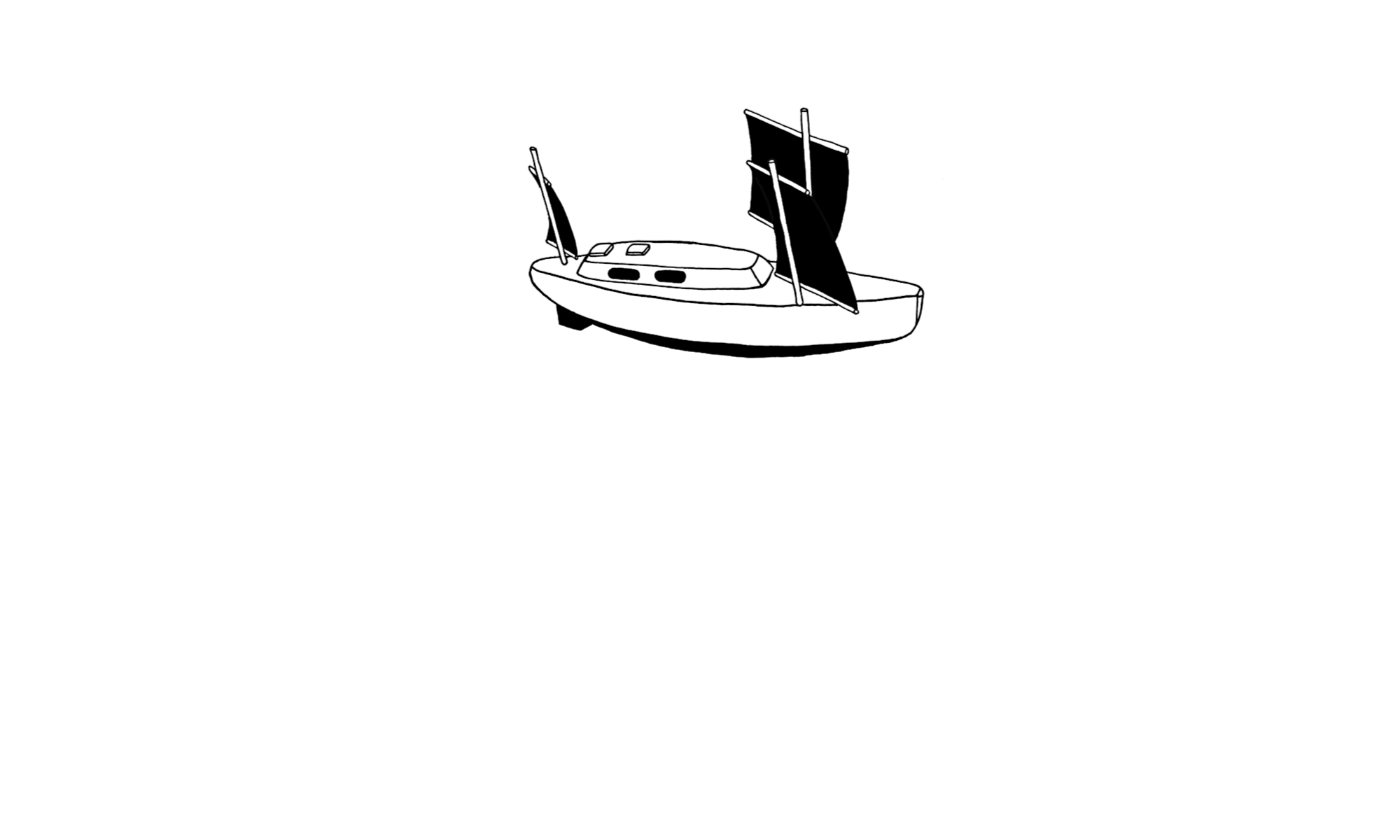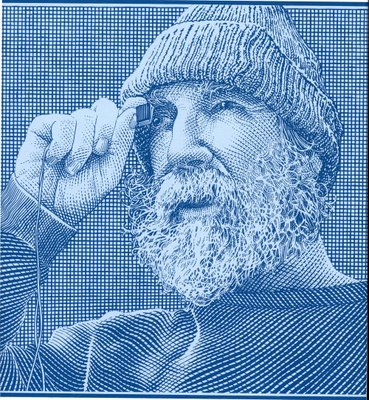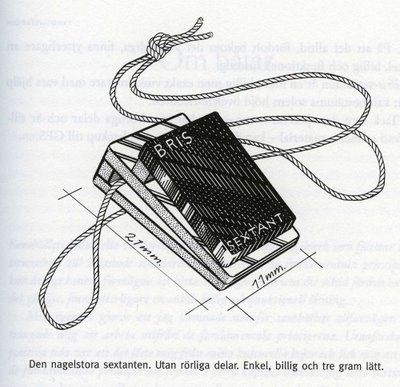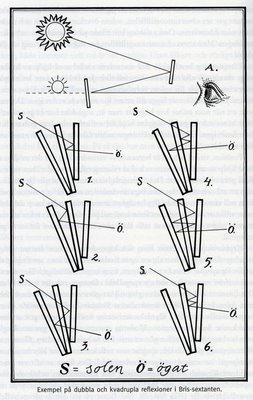BELOW ME WITH MY SEXTANT
THE DIMENSIONS OF MY SEXTANT
THE DOUBLE AND QUADRUPLE REFLECTIONS IN MY SEXTANT
WHEN THE SEXTANT IS ATTACHED TO MY GLASSES I GET AN ABSOLUTELY STEADY VIEW AND BOTH HANDS FREE AS THE BRIS-SEXTANT NEEDS NO ADJUSTMENTS
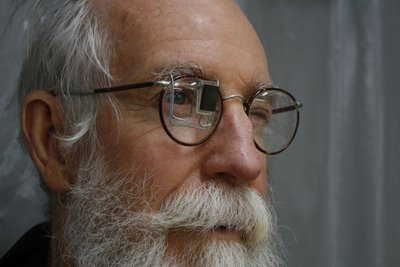
PHOTO JONAS EKBLAD
VIEW FROM THE SIDE
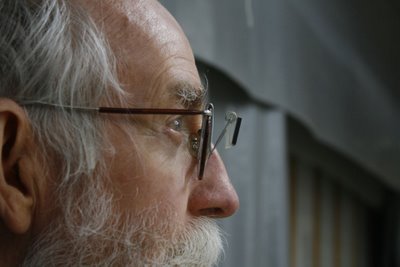
PHOTO JONAS EKBLAD
BRIS-SEXTANTS FOR SALE
1997 I produced a small altitude measurement instrument as a back up to my sextant. I soon realised that other sailors also could use it and that it can serve as a pedagogical toy for those interested in astro-navigation and that it makes a nice birthday gift. When the international yachting press published articles about my invention Cassen and Plath in Germany and Celestair in the USA started to sell them for me, but commercial production was boring so I only made a few before going back to mess around with my boats.
That is now many years ago. Today I need money to help finance my present project; therefore I will sell a limited number to private citizens. If you are one of those individuals who like to own, or give away, a unique BRIS-SEXTANT, please phone me, Swedish time 2000 to 2200 at +46 490 21530.
Here are some salient facts about my instrument.
It is smaller than most people’s thumbnails. Its weight is 3 grams or less than one eight of an ounce.
The common sextant consists of many parts, some moving; it is complicated and delicate and has a very accurate analogue scale. The BRIS-SEXTANT has no moving parts and no scale. It consists of carefully dimensioned spacers and a number of beam splitters, glued together to a unit with a specially formulated epoxy.
When a ray from the sun is double and quadruple-reflected between three beam splitters, three bright and five less bright images of the sun appears on the horizon as seen through the instrument.
I have built BRIS-SEXTANTS with higher number of beam splitters, they increase the numbers of the images in a combinatorial way. It is a fascinating exercise, but personally I prefer the three beam splitter sextant for its simplicity in looks and image pattern.
To find ones position at sea, in a small rocking boat, with the help of the sun, its altitude above the horizon has to be measured, from the top of a wave and during that limited time when the boat balances on the top of a wave. The measured error should, preferable, be not more than a minute of a degree. The BRIS-SEXTANT makes that possible by keeping the image of the sun steady on the horizon however much the boats rocks.
This amazing, inbuilt, freedom from change and variation is due to, that the images of the sun is always created by an even number of reflections. When the boat heals one way or the other, the first beam splitter reflects the image away from the horizon, but at the same instant, its mate, the second beam splitter which is glued to the first one moves the same distance in tandem, picks up the light beam and reflects it back to exactly the same position, free from change and variation. The impressive result is constancy. The principle is old and well proven. Radar reflectors and periscopes are other double reflecting devices that work equally well even though the angles of operation changes.
But there are more to angle measurements than constancy. It is not an easy art. Every angle consists of two lines and their intersection. The surveyor has to align his instrument first with one line then with the second. Early navigational instrument like the cross-staff also required the navigator to look in two different directions before the angle could be determined. This is of course time consuming and not suited for marine use as an altitude can only be measured during the limited time the boat is on the top of a wave. The sextant has changed all that. The instrument brings the sun down to the horizon so that the navigator can see the two endpoints of the angle he measures in one and the same placer.
The BRIS-SEXTANT has no scale, nor any mowing parts. It cannot be adjusted and there is no need to, because I chose simplicity over universality.
To explain how it works I will use a metaphor. A balance compares the unknown weight to a standard weight, a spring scale measures weight by the distance a spring deflects under its load. The ordinary sextant has a very precise scale engraved upon its arc. Its readout is analogical like the spring scale
The BRIS-SEXTANT has no scale; its readout is a bit like a balance, it compares the unknown quantity to a standard calibrated quantity.
In the case of the three beam splitter instrument each of the eight images of the sun are discrete standard calibrated quantities.
The business of the sun is to rise in the morning and set in the evening. When doing this she is pulling the images, created by the BRIS-SEXTANT, behind her like pearls on a string. All the observer has to do is to time them as they reach the horizon.
An evident but little realised fact is that two times a day you can determine the suns altitude without a sextant. Those two times are at the sunrise and at the sunset when the suns altitude is, of course, 0 degrees. With two timed observations of altitude you can calculate your position.
An observer using the ordinary sextant brings the sun down the sun to the horizon with the help of the index arm. Thereby he is creating an artificial sunrise or sunset. The instrument shows you how many degrees the sun has been lowered. Sextants are in fact sunset and sunrise repeaters.
Before you can measure the altitude with the BRIS-SEXTANT, all you have to do is to calibrate the instrument and it is no more difficult than taking an ordinary sight.
Three magnitudes are connected by equations. They are, time, position and the altitude of the sun. If two of them are known, the third can be calculated. To find the constants of the BRIS-SEXTANT, observe from a known position the horizon below the sun, through the BRIS-SEXTANT, keep it close to your eye, like when you look through a keyhole, never up at the sun. Take your time; watch as one of the images is getting closer and closer to the horizon. When the bottom limb or top limb or the centre of the sun is exactly on the horizon take the time. That done, use the time and your position to calculate the images constant, which is the suns altitude. Repeat the procedure for the other images. Make a table of the results. Later you can use the calibrated altitudes and time to calculate your position.
There are some relations between the constants. The difference between the suns upper and lower limb is obviously the suns diameter which is on the average 32 minutes of an arc.
If the three bright images are A, B and C and C is the biggest angle then A+B=C. The five less bright angles are 2A, 2B, 2C, A+C, B+C.
Because you have just determined the altitudes of the eight images by calibration and as the instrument has no moving parts there can be no errors, adjustable or nonadjustable. There are not even mirrors to resilver.
Sight corrections like index error, dip of horizon, refraction, semi diameter, parallax and so on are an important part of ordinary astro-navigation. Forget that when using a BRIS-SEXTANT. The reason is if you deduct them when correcting the sextant you have to add them when taking the sight. If you are very fussy you can note the time of year when you do the calibration because there is a small correction for the suns diameter and an even smaller for her parallax, but that’s for the advanced user.
An ordinary sextant takes up as much useful space as eight oranges or more, but if you don’t mind that and that it is a delicate instrument craving adjustments, it is a more universal instrument and unlike the BRIS-SEXTANT can be used to take a noon sight without a time piece to determine your latitude. The BRIS-SEXTANT is not meant to replace the ordinary sextant or GPS but to be used as a backup.
The BRIS-SEXTANT has no telescope, but in the hands of a good human eye, mine, I have measured altitudes time after time, from the steady platform of a beach, to an accuracy of one tenth of a minute of arc.
In a clean BRIS-SEXTANT you can see eight images of the sun. From each sun you can get tree readings, the lower limb on the horizon, the upper limb on the horizon and the centre on the horizon. Eight times three is twenty-four. You can make these same observations twice a day, in the morning when the sun rises and in the evening when the sun sets. In total with a BRIS-SEXTANT, in clear weather, you can make forty-eight observations each day. That is enough to make my small back-up instrument worth while.
As a bonus because the BRIS-SEXTANT is so small and light you can attach her to your glasses. There are two major advantages to this. First the image becomes dead steady. It is like watching a sunset without an instrument. It makes the observations very much easier. Second you got both your hands free so that you instantly can write down the time. The timing has to be done to the second, if accuracy is desired.
Don’t hesitate phone me and order your unique BRIS-SEXTANT. Swedish time 2000 to 2200 most days. Phone number +46 490 21530.
